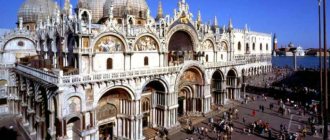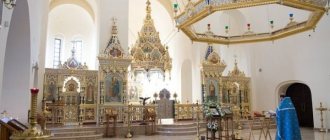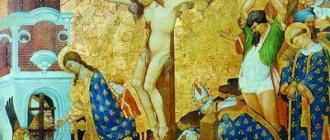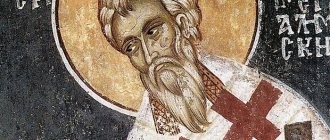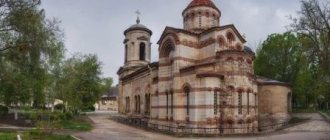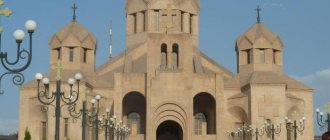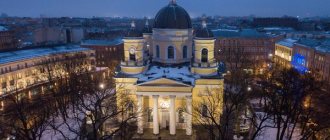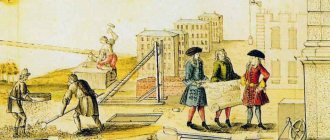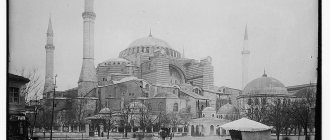St. Mark's Cathedral (Basilica San Marco) is located on the square of the same name next to the Doge's Palace and is a magnificent architectural example of the Byzantine style. The cathedral is famous all over the world and is a must-see when sightseeing in Venice.
In addition to the fact that this cathedral is a beautiful creation of architecture with an interesting history, it houses the relics of the Evangelist St. Mark, for which many believers come here to venerate.
A large number of works of art brought from Constantinople are also stored here, and the interior decoration of the cathedral and numerous mosaics will not leave even sophisticated tourists indifferent.
St. Mark's Basilica is also a UNESCO World Heritage Site.
History of the cathedral
The location of the relics of the Evangelist St. Mark until 828 was the city of Alexandria. When suppressing the peasant uprising that broke out there, Muslim punitive forces destroyed many Christian churches and destroyed shrines. Then two merchants from Venice sailed to the shores of Alexandria to protect the relics of St. Mark from vandalism and take them home. To get through customs, they resorted to a trick by hiding the basket with the remains of St. Mark under pig carcasses. Their hope that Muslim customs officers would disdain to lean against pork was justified. They successfully crossed the border.
Initially, the relics of the apostle were placed in the Church of St. Theodore. By order of Doge Giustiniano Partecipazio, a basilica was erected near the Doge's Palace to store them. The city gained the patronage of St. Mark, his sign in the form of a golden winged lion became the symbol of the capital of the Venetian Republic.
The fires that engulfed Venice in the 10th-11th centuries caused several reconstructions of the temple. Its reconstruction, close to its present appearance, was completed in 1094. A fire in 1231 damaged the church building, resulting in restoration work that ended with the creation of the altar in 1617. The majestic temple, outside and inside, appeared more beautiful than before, decorated with statues of saints, angels and great martyrs, and amazing carved decoration of the facades.
The cathedral became the main place of worship of the Venetian Republic. The coronations of doges were held there, famous sailors received blessings when setting off on long journeys, and townspeople gathered there on days of celebration and trouble. Today it serves as the residence of the Venetian Patriarch and is a UNESCO World Heritage Site.
Crypt
A crypt is a special room located underground and originally intended for storing relics. Here, before being transferred under the golden altar, the relics of St. Mark were kept.
Historians date the design of the crypt back to the time of the first basilica. In the center of the room stands a small chapel, richly decorated with marble. It was in the chapel that the relics of the apostle were originally buried. For some period, the crypt remained closed to the public, but since the fall of the Venetian Republic, religious services have been held here again.
Architectural features of the cathedral
The prototype of St. Mark's Cathedral was the Church of the Twelve Apostles. Its architectural design is based on a Greek cross, completed by a voluminous dome in the center of the intersection and four domes above the sides of the cross. The temple, with an area of 4 thousand square meters, rises 43 meters high.
Numerous reconstructions of the basilica harmoniously combined several architectural styles.
The facades harmoniously combine details of oriental marble with bas-reliefs of Romanesque and Greek styles. Ionic and Corinthian columns, Gothic capitals and many statues give the temple a divine majesty.
On the central western façade, 5 portals, decorated with mosaic tympanums of the 18th century and sculptural masterpieces from ancient to medieval eras, attract attention. The top of the main facade is decorated with thin turrets added 6 centuries ago, and in the center above the entrance rises a statue of St. Mark, surrounded by figures of angels. Beneath it, the figure of a winged lion shines with a golden sheen.
The southern facade is interesting with a pair of 5th century columns with carvings made in the Byzantine style. At the outer corner of the treasury, the statues of four tetrarch-rulers of the 4th century, brought from Constantinople, attract the eye. Exquisite Romanesque carvings, preserved from the 13th century, decorate most of the outer walls of the temple. Over the centuries, the building was completed with a narthex (XII century), a baptistery (XIV century) and a sacristy (XV century).
St. Mark's Square in Venice on the map
- Tours to the Dominican Republic for 9-11 nights, 3-5* hotels, all inclusive from RUB 106,653 for TWO – November
- Prague Zoo is one of the largest in Europe
- How to get to Rome
- Tours to Ayia Napa (Cyprus) for 9 nights, 3-5* hotels, breakfasts + dinners from 68,965 rubles for TWO – June
- Antalya hotels for families with children
- Rent a car in Burgas. What to see
- Haleakala National Park
- 15 Best Beach Resorts in the USA
- Banff National Park in Canada
- Turbidites on the coast of Barrique
- Sights of Sochi
- Moscow hotels with spa center
Luxury interior decoration
The decoration inside St. Mark's Cathedral, made in the traditional Venetian style, evokes delight and unprecedented spiritual uplift. The photos inside amaze you with the huge area and beauty of the mosaic paintings covering the vaults, the surface of the walls, domes and arches. Their creation began in 1071 and lasted almost 8 centuries.
Biography
Born in Cyrene, nephew (according to other translations - cousin) of the Apostle Barnabas (Col. 4:10). According to another version, Evangelist Mark was born in Jerusalem.
Mark was a disciple of the Apostle Peter. In 1 Peter he is referred to as “Mark my son” (1 Peter 5:13). According to legend, on the night of Christ’s capture in the Garden of Gethsemane, the Apostle Mark followed him, wrapped in a cloak, and ran away from the soldiers who grabbed him (Mark 14:51-52).
According to legend, he founded the Church in Egypt and was the first bishop in Alexandria. Here he laid the foundation for a Christian school. Preaching the Gospel, he traveled to Libya, Nectopolis, and visited the interior of Africa. Visited the Apostle Paul in Rome, where he was in prison. According to legend, here the Apostle Mark wrote the Gospel for the pagan believers. Ancient church writers testify that the Gospel of Mark is a brief record of the sermon and stories of the Apostle Peter. Returning to Alexandria, Mark strengthened the believers, opposing the pagans, which aroused their hatred. Saint Mark, foreseeing his end, hastened to leave behind successors - Bishop Ananias, whose sick hand he healed, and three presbyters. Soon the pagans attacked him during worship, beat him, dragged him through the streets of the city and threw him into prison. At night the Savior appeared to him and encouraged him. The next morning, a crowd of pagans again barbarously dragged the Apostle Mark to the judgment seat, but on the way the holy evangelist died with the words: “Into Your hands, O Lord, I commend my spirit.”
. It was April 25 [23], 68 (according to another version - 63 years).
Mosaics of the narthex
The narthex is the church porch that precedes the entrance to the basilica. Its extension with mosaic paintings illustrating Old Testament scenes dates back to the 12th-13th centuries. What appears before your eyes is:
- A dome about the creation of the world, decorated with gold flakes and an eye-catching image of the 6 days of the creation of the world from the book of Genesis.
- The arches of the doors opening the entrance to the temple attract attention with a cycle of mosaics about the lives of the ancestors, their children, the events of the global flood and some biblical scenes.
- The three domes of Joseph on the north side of the porch introduce 29 episodes from the biblical biography of Joseph the Beautiful. On the sails of the domes, figures of prophets appear with scrolls, where prophecies about the appearance of the Savior are written.
- The dome of Moses is painted with a mosaic of 8 scenes of acts committed by the prophet Moses.
Worship services and other visiting opportunities
Entrance to the church is free, but a certain religious dress code must be observed. Women must cover their heads, shoulders, legs and arms, while men must remove their hats upon entry. Photography and video recording are prohibited.
Orthodox services are held every year on July 8th. The cathedral also regularly hosts large Sunday services and excursions.
Cathedral opening hours from November to June:
- Mon-Sat: 9.45-16.00;
- Sun: 14.00-16.00.
From June to October:
- Mon-Sat: 9.45-17.00;
- Sun: 14.00-17.00.
Subjects of mosaics of the cathedral interior
The mosaics of the cathedral continue the mosaic narratives of the narthex, associated with the expectation of the appearance of the Messiah. They illustrate the lifetime acts of Jesus Christ, the lives of the Blessed Virgin Mary and the Evangelist Mark:
- From the dome on the central nave (the elongated room of the cathedral) the Virgin Mary, surrounded by prophets, looks out. 10 wall mosaic paintings and 4 scenes above the iconostasis, made according to sketches by the famous Tintoretto in the 14th century, are dedicated to the theme of the fulfillment of prophecies.
- Mosaics of the transverse nave (transept), telling about the events described in the New Testament and the good deeds of Jesus, became the decoration of the walls and vaults.
- The picturesque canvases of the arches above the central dome show pictures of the torment experienced by Christ, from the crucifixion to the Resurrection. In the center of the dome, the parishioners see a picture of the Ascension of the Savior into heaven.
- In the sacristy, the top of the walls and vaults are decorated with a number of 16th-century mosaics, made according to sketches by Titian.
- A floor made of multi-colored marble tiles arranged in geometric and floral patterns depicting the inhabitants of the earth's fauna looks like a work of art.
Visit also
Of course, your acquaintance with Venice should begin with a visit to San Marco Square, where you can see not only the cathedral, but also the famous Doge's Palace, located nearby.
The Doge's Palace is known as the residence of the Venetian doges and is the central building of Venice. In addition to its interesting architectural design, the palace is famous for the huge number of works of art stored within its walls and the historical significance of its halls.
Photo: Don Mammoser / Shutterstock.com
In the Doge's Palace, not only tribunals and meetings of the first representatives of government took place, but also justice was administered.
From the Doge's Palace you can walk onto the infamous Bridge of Sighs, which connects the magnificent palace with the prison where convicts were sent after their sentences were passed. By the way, Casanova was also imprisoned in this prison - the only prisoner who managed to escape from this terrible place.
Golden Altar
A priceless relic of the Cathedral of St. Mark and Venice is considered to be the “golden altar” - Pala D'Oro, which took about 500 years to create. The height of the unique cult creation is more than 2.5 meters, and the length is approximately 3.5 meters. The altar attracts attention with 80 icons framed in gold, decorated with many precious stones. It stuns the imagination with 250 enamel miniatures created using a unique technique.
The center of the altar is dedicated to Pantocrator, the heavenly king seated on the throne. On the sides it is surrounded by round medallions with the faces of the apostle-evangelists. Medallions with archangels and cherubs are placed above his head. On the upper rows of the iconostasis there are icons with gospel scenes; from the icons on the lower rows, forefathers, great martyrs and prophets look down. On the sides of the altar there are vertical images of the biographies of St. Mark. Free access to the treasures of the altar allows you to examine all the details and enjoy the divine beauty.
San Marco: practical information for tourists
How to get there
To get to Piazza San Marco, you need to either use water transport or walk (there is simply no land transport in this part of the city!) The old part of Venice is not that large, and walking around it is very pleasant, so do not neglect this option if you have time and energy. If you are in a hurry, go to the main attraction of Venice by vaporetto (water bus - this type of transport in Venice serves as a public transport).
From Piazzale Roma , where ( 20 minutes) and 2 direct (30 minutes) go to Piazza San Marco. The walk takes about 40 minutes.
From the Santa Lucia train station , where tourists traveling by train arrive, the walk takes 30-45 minutes, depending on the route chosen. You can get there by the same vaporetto: No. 1 takes about 35 minutes, routes 51 direct and 2 direct take about 25 minutes.
Vaporetto runs frequently, every 10 minutes. You need to get off at the San Marco stop.
You can also, of course, always take water taxis.
Visiting the museums of San Marco
There is a single ticket for visiting 4 museums located in Piazza San Marco : the Doge's Palace, the Correr Museum, the National Archaeological Museum and the Monumental Halls of the Marciana Library. You can buy tickets online here. If you need a reservation in Russian, then here.
You can also purchase a Museum Pass to visit 11 Venetian museums.
Opening hours of attractions
Cathedral of San Marco
The basilica is open on weekdays from 9.45 to 17.00, on Sundays and holidays - from 14.00 to 16.30 or 17.00, depending on the season. Entrance to the Museum and Treasury closes earlier.
Entrance to the basilica is free, but if you want to separately visit the altar with the relics of the Apostle Mark and explore the Pala d'Oro, the treasury, the basilica museum, and the bell tower, you will need to pay from 2 to 5 Euros.
Official website of the Cathedral of San Marco: www.basilicasanmarco.it
Visiting the Cathedral of San Marco: life hacks
- Although entry to the basilica itself is free, not all tourists want to waste time in huge queues to enter. You can avoid them by purchasing a special ticket on the official website.
- Photography and video shooting are prohibited inside the basilica.
- The interior of the cathedral is usually quite dark, which can make it difficult to view the magnificent frescoes. Few people know that the temple is fully illuminated only at certain hours: from 11.30 to 12.45 on weekdays and all day on Sundays and church holidays.
- Allow about 10 minutes to examine the interior of the Basilica of San Marco - you won’t be able to stay inside for long (this limit does not apply to the rooms of the Treasury and the Golden Iconostasis).
Doge's Palace
Opening hours: 8.30–19.00 (entrance until 18.00) Official website: https://palazzoducale.visitmuve.it/
You can visit the Doge's Palace only by purchasing a single ticket for visiting 4 museums in Piazza San Marco or a Museum Pass.
Bell tower of San Marco
Opening hours: from 5 to 18 September 8.30–20.15; from 19 to 30 September 8.30-19.45; from 1 to 9 October 9.30-19.00, from 10 to 31 October 9.30-17.30; from November 1 to March 31 9.30-17.30; closed from 9 to 27 January; from 1 to 30 April 9.00-17.30; from May 1 to September 4 8.30 – 21.00. In bad weather conditions (fog, strong wind or cold), access to the bell tower is closed. Tickets can be purchased here.
Popular cafes in Piazza San Marco
There are plenty of cafes and restaurants on St. Mark's Square. The most famous are " Florian " and " Quadri ". The legendary cafe "Florian" is one of the oldest in Italy. It is believed that its history dates back to the 18th century! Its rich history and luxurious interiors have always attracted a sophisticated audience, including many famous personalities. Today, any wealthy tourist can touch the history and luxury of Floriana. Tables for customers are located right on the street. Traditionally, people come here to watch the sunset over a cup of aromatic coffee, which gradually hides behind the domes of San Marco Cathedral. But you will have to pay a lot of money for this pleasure - cafes are expensive.
Evening Piazza San Marco
Tips for tourists visiting San Marco
- For an excursion to St. Mark's Square, you should choose comfortable shoes, since you will have to walk a lot and possibly travel by boat. As you can imagine, this is not very convenient to do in heels.
- And when visiting the cathedral, do not forget about the dress code: clothes must cover your shoulders, shorts and miniskirts are not welcome.
- Piazza San Marco is famous for its large number of pigeons. You can feed them only with special pigeon food with a sterilizing agent. There is a fine for unauthorized sale of food.
- Many people come to Venice for just one day, and immediately from the station they rush to the heart of the city - to Piazza San Marco. In this case, the issue of luggage arises. For the convenience of tourists, the Cathedral of St. Mark the Apostle has a storage room - it is located on the northern façade and Piazzetta dei Leoncini. Large bags, backpacks and suitcases are not allowed into the basilica itself.
- As a rule, souvenirs in Piazza San Marco are highly overpriced, but move a little further from the square and you can buy the same things at a lower price.
- If possible, we recommend visiting San Marco early in the morning before the square is flooded with tourists. At this time, a very special atmosphere reigns there, and you can enjoy the beauty of the square without pushing through crowds of selfie lovers.
- We also recommend exploring St. Mark's Square and St. Mark's Basilica, as well as the surrounding attractions, with our fascinating audio guide to Venice . The Travelry mobile app offers excursions along the most interesting routes. Explore the city with inspiration!
Bell tower
Near St. Mark's Cathedral rises the Campanile, a cathedral bell tower in the form of a square tower. It is completed by a belfry topped with a spire on which is installed a copper figure of the Archangel Michael. The total height of the bell tower reaches 99 meters. Residents of Venice lovingly call the bell tower of St. Mark's "mistress of the house." Throughout its long history, dating back to the 12th century, it managed to serve as a watchtower, lighthouse, observatory, belfry and a magnificent observation deck.
In the autumn of 1902, the bell tower building suddenly collapsed, after which only the corner part and the 16th century balcony with marble and bronze decoration survived. The city authorities decided to restore the Campanile to its original appearance. The renovated bell tower was opened in 1912 with 5 bells, one of which is original, and four were donated by Pope Pius X. The bell tower offers an amazing panorama of Venice with the nearby islands.
Baptistery
The Baptistery is a temple room decorated with marble and magnificent mosaics, intended for the baptism of infants. Here in the very center there is a stone font covered with a bronze lid. In the baptistery there is a monument to Doge Andrea Dandolo, which is considered the most revered and significant in the history of the republic.
Interesting Facts
- About a hundred thousand larch logs were used for the large-scale construction of the Church of San Marco, which only became stronger under the influence of water.
- More than 8,000 square meters are covered with mosaic images on a golden background. m of vaults, walls and domes of the temple.
- The “Golden Altar” is decorated with 1,300 pearls, 300 emeralds, 300 sapphires, 400 garnets, 90 amethysts, 50 rubies, 4 topazes and 2 cameos. Below him in a shrine lie the relics of St. Mark.
- The enamel medallions and miniatures that decorated the altar were selected by the crusaders from the Pantocrator monastery in Constantinople during the fourth campaign and donated to the temple.
- The treasury of the cathedral exhibits a collection of Christian relics, gifts from the popes and about 300 objects obtained by the Venetians during the defeat of Constantinople at the beginning of the 13th century.
- A quadriga of bronze horses, cast in the 4th century BC by Greek sculptors, is preserved in the treasury of the basilica. At the top of the façade is an elaborate copy of them.
- Part of the basilica is the chapel of St. Isidore, revered by the Venetians. In it, under the altar, lie the remains of the righteous.
A large-scale performance with the “miraculous” discovery of a relic
The kidnapping story didn't end there. The Venetian authorities, fearing that the Alexandrians would find out about the theft of the relic, staged a large-scale performance with the “miraculous” discovery of the holy relics.
In 1904, all residents of Venice were ordered to pray to the Lord to indicate the location of the relics. As a result of a mass prayer session, God “heeded” the requests of the townspeople: during the service, a marble slab collapsed, and a “miracle” was revealed to the eyes of the believers - the relics of the Holy Apostle Mark.
